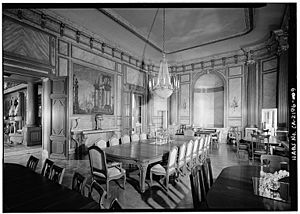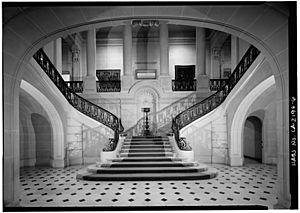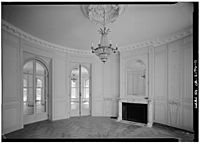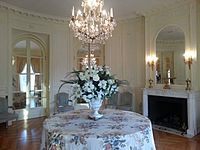Carolands facts for kids
Quick facts for kids Carolands Chateau |
|
|---|---|

West façade, 2006
|
|
| Alternative names | Carolands, Remillard Manor, The Chateau |
| Etymology | Harriett Pullman Carolan |
| General information | |
| Architectural style | Beaux-Arts Classicism |
| Address | 565 Remillard |
| Town or city | Hillsborough, California |
| Country | United States |
| Coordinates | 37°33′19.8″N 122°22′14.7″W / 37.555500°N 122.370750°W |
| Groundbreaking | 1914 |
| Completed | 1916 |
| Renovated | 1998–2002 |
| Cost | est. US$1,000,000 (equivalent to $28,927,632 in 2022) |
| Renovation cost | est. US$20,000,000 (equivalent to $32,540,241 in 2022) |
| Owner |
|
| Height | 100 feet (30 m) |
| Dimensions | |
| Other dimensions | 130 feet (40 m) x 120 feet (37 m) |
| Design and construction | |
| Architect |
|
| Renovating team | |
| Renovating firm | Doug Wilson |
| Other designers | Mario Buatta |
| Other information | |
| Number of rooms | 98 |
|
Carolands
|
|
| NRHP reference No. | 75000478 |
| Added to NRHP | October 21, 1975 |
| Official name: Carolands | |
| Designated: | 9 May 1975 |
| Reference #: | 886 |
The Carolands Chateau is a huge mansion located in Hillsborough, California. It has 98 rooms and covers about 46,050 square feet. This amazing building is a great example of Beaux-Arts architecture, a fancy style from the late 1800s and early 1900s.
Carolands is recognized as a California Historical Landmark. It is also listed on the National Register of Historic Places. This means it's a very important building in American history. It's one of the last grand homes built during the "Gilded Age." This was a time when many rich families, like the Vanderbilts, built huge mansions. Famous examples include Marble House and Biltmore Estate.
History of Carolands Chateau
Who Built Carolands?
The person who built Carolands Chateau was Harriett Pullman Carolan (1869–1956). She was the daughter of George Pullman. He was a very rich businessman from Chicago. George Pullman was famous for his luxurious railway cars.
In 1892, Harriett married Francis Carolan and moved to California. In 1912, she bought a large piece of land in Hillsborough. She wanted to build a house and garden that everyone would admire. The chateau was designed to show off her refined tastes. It was inspired by the grand palaces of French kings. Harriett chose the highest spot in the area. This gave her amazing views of the San Francisco Bay.
The Architects Behind the Design
Harriett Carolan hired famous architects to design her dream home. The main architect for the chateau was Ernest Sanson from Paris. He was known for designing beautiful private homes. Sanson's design for Carolands was inspired by 17th-century French architecture. He was quite old and never visited the site in California.
So, Harriett hired Willis Polk, a talented architect from San Francisco. Polk was in charge of building the chateau. He made sure Sanson's designs were followed exactly.
The gardens were designed by Achille Duchêne, a leading French landscape architect. Duchêne was inspired by André Le Nôtre. Le Nôtre designed the famous gardens at the Palace of Versailles. Duchêne planned huge gardens for Carolands. They would have miles of paths, thousands of trees, and many fountains. However, only a small part of his grand plan was ever built.
Building the Grand Chateau
Construction on Carolands began in 1914. Willis Polk started by preparing the land for the gardens. He sent photos of the progress to the architects and Harriett. Polk then built the main structure using strong concrete. The walls were made of brick and covered with stucco. This made them look like natural limestone.
By mid-1916, the fancy interior parts started to arrive. The house ended up with 98 rooms. This included nine bedrooms and bathrooms for the owners and their guests. Each bedroom had a small extra room to ensure quietness. The service areas were also very detailed. The kitchen had white glass tiles on the walls and ceiling. There was a service elevator connecting all floors. In the fall of 1916, Harriett and Frank Carolan moved in.
First Challenges for Carolands
Harriett Carolan did not live in the house for very long. She separated from Frank Carolan in 1917. She then closed the chateau the following year. Harriett moved to New York City. Frank stayed in California and passed away in 1923.
Later, Harriett married Arthur Schermerhorn. They sometimes stayed at Carolands. But in 1928, Harriett removed her furniture and put the house up for sale.
The U.S. Government thought about buying Carolands in 1939. They considered it again during the Kennedy administration. Both times, they decided not to buy it.
In 1945, Tomlinson Moseley bought the house and its land. He started dividing the land to build more houses. In 1947, Life Magazine featured a charity event held at the house. This was the first time many people in the San Francisco area saw its inside. The article said the house had been empty for 25 years. They even needed fire hoses for plumbing!
In 1948, Moseley sold the property. By then, the land was much smaller. By 1950, the new owner, Mrs. S. Coe Robinson, thought about tearing down the house.
Countess Lillian Remillard Dandini Saves the Chateau
Countess Lillian Remillard Dandini bought Carolands Chateau in 1950. She saved it from being torn down. She was an heir to a brick manufacturing business. This business became very successful after the 1906 San Francisco earthquake.
The Countess lived at Carolands for 23 years. She often hosted parties and charity events. She also invited the French community and French students to visit. Her kindness in sharing the house was well-known. The town of Burlingame even gave her a "Woman of the Year" award.
In her later years, the Countess found it hard to pay for the house's upkeep. After she passed away in 1973, Carolands was again at risk. The Countess wanted to give the house to the town of Hillsborough. She hoped it would become a center for music and art. However, she couldn't leave money for its care. The town decided not to accept the gift. They said they couldn't afford to maintain it.
More Difficult Years
In 1975, Carolands was recognized as a California Historical Landmark. It was also added to the National Register of Historic Places. Despite this, the house changed owners many times.
In 1976, Rose 'Roz' Franks bought the house. In 1979, George I. Benny took ownership. He later lost the house due to legal problems. During these years, Carolands was often empty.
In 1986, Michael DeDomenico bought Carolands. He was from the family that owned Rice-a-Roni and Ghirardelli Chocolate. In 1989, an earthquake caused minor damage to the house. This made the owners think about tearing it down. In 1997, a new owner wanted to turn the house into apartments. But the town rules did not allow multi-family homes.
The Chateau's Restoration
In 1991, Carolands hosted a "Designer Showhouse" event. This brought 68,000 visitors to the house. It raised over $1 million for charity. This event helped bring new interest to the house. Among the visitors was Dr. Ann Johnson. She would later buy Carolands. Her interior decorator, Mario Buatta, helped her restore it.
In 1998, Dr. Ann Johnson and her husband, Charles Johnson, bought the house. They paid less than $6 million. Dr. Johnson started a huge renovation project. They fixed the heating and cooling systems. They removed old materials like asbestos. They also replaced the roof. The Johnsons carefully restored the inside of the house. They wanted it to look as it did when it was first built.
Like the Countess Dandini, the Johnsons often shared the house. They hosted charity events and other good causes. Their main goal was to save Carolands for future generations.
Carolands Today
In 2012, the Johnsons gave the house to the Carolands Foundation. This foundation now manages the property. They offer tours for small groups. You can find more information on their website.
Images for kids
Outside Views
Garden Views
Inside Views
Carolands in Media
In 2006, a documentary film called Three Women and a Chateau was released. It tells the nearly 100-year story of Carolands. The film won an award at the Rhode Island International Film Festival.
Another documentary, The Heiress and Her Chateau: Carolands of California, came out in 2014. It was shown on PBS and was nominated for two Emmy Awards. Both films were made by Luna Productions.
See also
 In Spanish: Carolands para niños
In Spanish: Carolands para niños


















